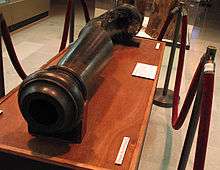Prize of war

A prize of war is a piece of enemy property seized by a belligerent party during or after a war or battle, typically at sea. This term was used nearly exclusively in terms of captured ships during the 18th and 19th centuries.
Rules defining how prizes were claimed and administered originated before there were organized government navies and were an outgrowth of privateering.[1]
Prizes of war at sea are unlikely in major modern conflicts due to changes in the way wars are fought and financed, international law and oversight, and the possibility of a prize being booby trapped. However the Hague Conventions of 1899 and 1907 do allow for war materiel to be claimed as trophies of war as does US law. [2]

Prizes in World War II included a German submarine later called HMS Graph, and U-505 which was captured by elements of the United States Navy in a task force commanded by then-Captain Daniel V. Gallery. U-505 currently is a museum ship at the Museum of Science and Industry in Chicago.
Although not taken in combat, two Gorch Fock class barques were confiscated from Germany as reparation prizes at the conclusion of World War II, one of which remains in US service as USCGC Eagle (WIX-327).
Quantities of Iraqi military materiel captured during the Gulf War is held by US museums[3]

Materiel captured as a result of the Falklands War was reused by the British Armed Forces. This included two Agusta A109 helicopters captured by the British Army from the Argentine Army which were used by the Army Air Corps until 2007.
See also
- Copenhagenization (naval)
- List of ships captured in the 18th century
- List of ships captured in the 19th century
- Prize (law)
- Prize money
- Spoils of war
- War trophy
References
- ↑ Petrie, Donald A. Prize Game, The: Lawful Looting on the High Seas in the Days of Fighting Sail. ISBN 0-425-17829-3.
- ↑ Wegener, Corrine (April 2005). "Law & Ethics: Truth and Booty". Internet Archive. American Association of Museums. Archived from the original on April 12, 2012. Retrieved 18 January 2016. Archived April 12, 2012, at the Wayback Machine.
- ↑ Chicago Tribune